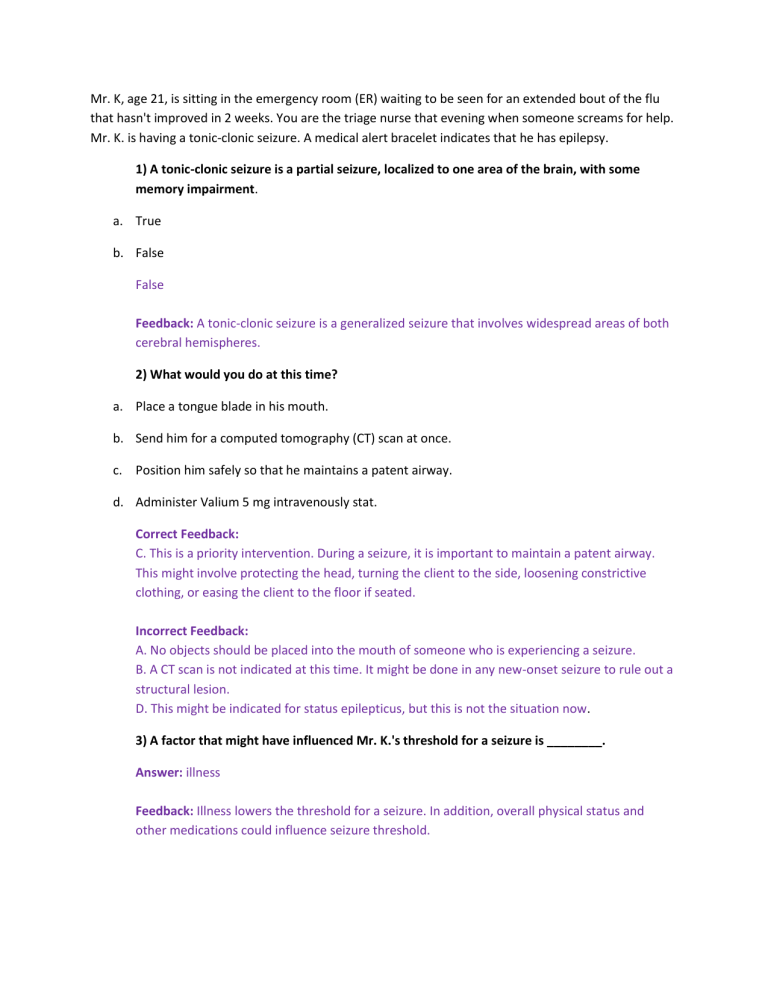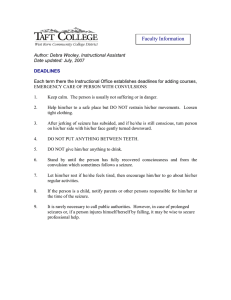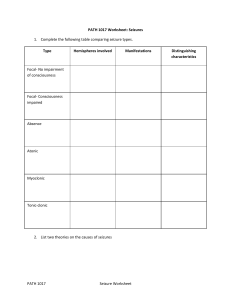Epilepsy & Seizure Management: A Case Study Quiz
advertisement

Mr. K, age 21, is sitting in the emergency room (ER) waiting to be seen for an extended bout of the flu that hasn't improved in 2 weeks. You are the triage nurse that evening when someone screams for help. Mr. K. is having a tonic-clonic seizure. A medical alert bracelet indicates that he has epilepsy. 1) A tonic-clonic seizure is a partial seizure, localized to one area of the brain, with some memory impairment. a. True b. False False Feedback: A tonic-clonic seizure is a generalized seizure that involves widespread areas of both cerebral hemispheres. 2) What would you do at this time? a. Place a tongue blade in his mouth. b. Send him for a computed tomography (CT) scan at once. c. Position him safely so that he maintains a patent airway. d. Administer Valium 5 mg intravenously stat. Correct Feedback: C. This is a priority intervention. During a seizure, it is important to maintain a patent airway. This might involve protecting the head, turning the client to the side, loosening constrictive clothing, or easing the client to the floor if seated. Incorrect Feedback: A. No objects should be placed into the mouth of someone who is experiencing a seizure. B. A CT scan is not indicated at this time. It might be done in any new-onset seizure to rule out a structural lesion. D. This might be indicated for status epilepticus, but this is not the situation now. 3) A factor that might have influenced Mr. K.'s threshold for a seizure is ________. Answer: illness Feedback: Illness lowers the threshold for a seizure. In addition, overall physical status and other medications could influence seizure threshold. 4) Mr. K's seizure continues without regaining consciousness. This might represent ________ ____________. Answer: status epilepticus Feedback: Status epilepticus is an emergency situation in which seizures recur in rapid succession and the client does not regain consciousness. It lasts at least 30 minutes and is a life-threatening situation. 5) The major cause of status epilepticus is ________________________________. Answer: noncompliance with medications Feedback: Not taking prescribed medications can result in more frequent seizure occurrence and status epilepticus. Status epilepticus can also be caused by central nervous system disorders, low blood sugar level, or low blood calcium level. 6) Status epilepticus is a life-threatening situation because permanent brain damage might result. a. True b. False Answer: True Feedback: Neurons become exhausted and cease to function. In addition ventilatory failure, hypoxia, dysrhythmias, and acidosis can occur. All of these situations can be fatal. 7) A drug of choice in this situation is__________________________. a. b. c. d. carbamazepine (Tegretol) divalproex (Depakote) primidone (Mysoline) diazepam (Valium) Correct Feedback: D. Diazepam is a fast-acting benzodiazepine given intravenously for the termination of status epilepticus. Incorrect Feedback: A. This is an anticonvulsant drug given orally for a generalized tonic-clonic seizure, but it is not indicated in this emergency situation. B. This is an anticonvulsant drug given orally for a generalized tonic-clonic seizure, but it is not indicated in this emergency situation. C. This is an anticonvulsant drug given orally for a generalized tonic-clonic seizure, but it is not indicated in this emergency situation. 8) When administering an intravenous benzodiazepine such as Valium, the nurse carefully monitors ___________________. Answer: vital signs Feedback: Baseline vital signs need to be obtained prior to dosing with Valium. Respirations should be assessed before doses, and the client should be assessed for respiratory depression and hypotension during administration and for at least 3 hours afterward. Emergency equipment must be readily available. 9) Mr. K's seizure is controlled and he is transferred to a medical unit. The physician plans a loading dose of fosphenytoin sodium (Cerebyx) 750 mg PE IV Soluset. Fosphenytoin is ordered instead of phenytoin (Dilantin) because it is more effective in controlling seizures. a. True b. False Answer: False Feedback: Fosphenytoin rapidly converts to phenytoin in the body. It has the same pharmacologic profile as phenytoin sodium. 750 mg fosphenytoin sodium is equivalent to 500 mg phenytoin sodium. Phenytoin also is irritating to tissue and veins and is incompatible with many solutions, making fosphenytoin a better choice. 10) The maximum rate of intravenous administration of fosphenytoin is ________. Answer: 150 mg/min Feedback: Fosphenytoin 150 mg is equivalent to 100 mg phenytoin sodium. The IV infusion rate should not exceed 150 mg PE/min as a loading dose. The maintenance dose is 4 to 6 mg PE/kg/day IV. 11) In assessing Mr. K., you discover that he has been noncompliant with his prophylactic seizure medications at home. A factor that you consider when planning your interventions to address his noncompliance is ________. Answer: knowledge Feedback: When examining noncompliance, the nurse should consider knowledge of his drug regimen and take into consideration his age and developmental tasks, his financial status, his self-image and goals, and his use of other substances such as alcohol. 12) Mr. K. will be discharged on phenytoin sodium (Dilantin). The nurse teaches him oral hygiene, including brushing his teeth frequently, flossing, and massaging his gums. This helps prevent ____________ ________________. Answer: gingival hyperplasia Feedback: Tissue overgrowth is usually more obvious anteriorly than posteriorly, and the client might have body image concerns. Regular dental care together with measures to control plaque will minimize hyperplasia. 13) The range for therapeutic phenytoin level is ________ mcg/mL. Answer: 10 to 20 Feedback: Monitoring for a therapeutic level of 10 to 20 mcg/mL is important for accurate dosage administration and as a mechanism of determining compliance. 14) Mr. K. asks about a resource to help him learn more about his epilepsy. A voluntary agency that offers a variety of services to individuals with epilepsy at no cost is the _______________________. Answer: Epilepsy Foundation Feedback: Support from others with epilepsy as well as information on current care and management will empower Mr. K. and foster compliance.



